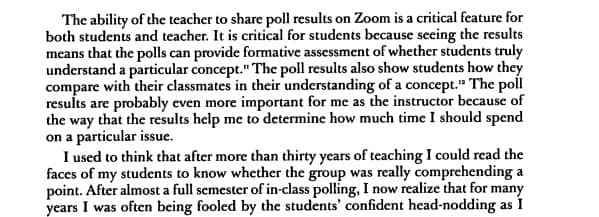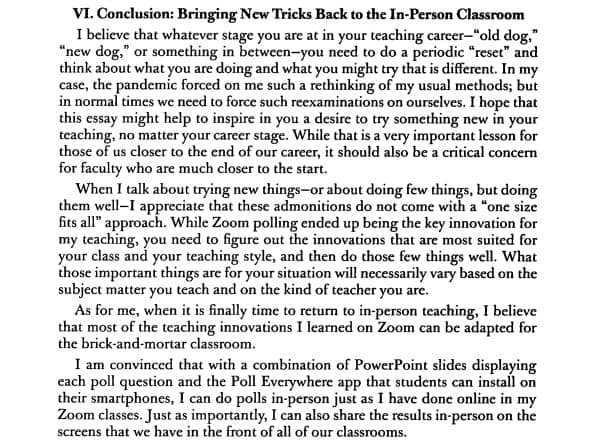The week before Spring Break in March of 2020 I, along with thousands of other educators across the country, found out via email that I had one week to adapt four in-person college writing courses into remote classes for the remainder of the semester. In the midst of the first wave of lockdowns that year, as COVID-19 was still so poorly understood, many of us (myself included) assumed that this would be only a brief interruption in our usual teaching routines. We were very much mistaken. Fall and Spring 2021 saw me, and my colleagues at the University at Buffalo, continuing to teach almost entirely online.
My university returned to primarily in-person instruction in the Fall of 2021. However, there is a growing sense among educators and administrators that online teaching is going to be an essential part of the fabric of higher education from hereon out. Teaching online is here to stay. In fact, it has been here for a while. The first online courses were offered in the 1980s and, arguably, the first modern distance learning college courses were delivered by the University of Chicago in 1892.
Keep reading for some tips on teaching online that you can use in your own classroom (virtual or otherwise), along with some recommendations for further reading on the subject in HeinOnline.
Use the unique features of Zoom to your advantage
One of the biggest mistakes I made when first teaching online was trying to replicate the experience of an in-person classroom in an online space. While some aspects of a traditional classroom can be transposed directly to online platforms, others cannot be easily recreated. For instance, organic pre-class banter—the often valuable informal conversation in the handful of minutes between arriving in the classroom and the beginning of class—is something that just does not translate to teaching online, in my experience.
The good news is, there are a number of unique things about teaching online that have the potential to enhance the learning experience for our students, and even to make our lives as teachers a little bit easier. Zoom, probably the most common platform for synchronous online learning since 2020, offers a number of features that can be very useful in encouraging active learning and participation. One such feature of Zoom (and one which is widely available, in various forms, on other platforms) is the ability to conduct polls of students in real time. This is a feature that Daniel Keating, Tyrell Williams Professor of Law at Washington University in St. Louis, used with great success in his law courses online. Keating describes his use of polls—along with other experiments, both successful and otherwise—in his article “Finding New Classroom Tricks in a Virtual World: One ‘Old Dog’s’ Tale.”[1]Daniel Keating, Finding New Classroom Tricks in a Virtual Teaching World: One ‘Old Dog’s’ Tale, 70 J. Legal Educ. 462 (2021). This article is found in HeinOnline’s Law Journal Library.

Polls are great not only as a way to encourage active learning, but as a way for us as instructors to solicit feedback and assess how well students are comprehending course content. Keating found that, in many cases, the polls provided a more accurate assessment of student learning than his own intuition of student cues in person—so much so that he plans to incorporate Zoom-style polling into his future in-person classes.

The chat function is another useful tool for teaching online, as it provides an opportunity for participation for students who might be reluctant to engage in discussion aloud. And it offers students the opportunity to ask me questions directly and individually, in real time, that they might be reluctant to ask in front of their peers or which might be disruptive to the flow of a lecture or class discussion (e.g. the “do we have any homework today?” mid-lecture non-sequitur).
I would also be remiss here if I did not mention that HeinOnline integrates a number of useful features that can be readily adapted for use in teaching online. Last month, for example, I wrote about using HeinOnline’s MyHein feature to help students organize group research projects. This tool would be especially valuable in an online context, as it provides students with a shared virtual space for research resources.
Be flexible and generous with your students
According to the U.S. Department of Commerce, 40 percent of full-time undergraduate students and 74 percent of part-time students were employed at least part-time while enrolled in courses. In my experience, this is even more true for students who choose to enroll in online courses. Data suggests that students who choose to enroll in online courses are more likely to have careers, and to be older than their more “traditional” colleagues taking courses in person. Students, in short, have a lot going on in their lives beyond their classes.
Although I think kindness and generosity should be paramount to any course, they are particularly important to online courses. We’re nearly at the end of the spring semester, and many of us are beginning to think of our syllabi for next school year. As you begin to do so, I would recommend taking some time to read Matthew Cheney’s excellent essay on crafting course policies, “Cruelty-Free Syllabi.” Cheney premises his approach to course policies on communication and conversation. The idea here is, teaching online throws up enough barriers between us and our students as is. Why create more?
Further Reading
There are numerous articles in our collection COVID-19: Pandemics Past and Present about the impact of the COVID-19 pandemic on education in the United States and around the world (see the LibGuide here). You can find some fascinating reports on the specific impact of the pandemic and distance learning on LGBTQ+ students[2]Kerith J. Conron; et al. UCLA School of Law Williams Institute. COVID-19 and Students in Higher Education (2021). This report is found in HeinOnline’s COVID-19: Pandemics Past and Present. and students experiencing poverty,[3]U.S. Gov. Accountability Office, GAO-22-105815, Pandemic Learning: Teachers Reported Many Obstacles for High-Poverty Students and English Learners As Well As Some Mitigating Strategies (2022). This report is found in HeinOnline’s COVID-19: … Continue reading and congressional hearings on the impact of teaching online on students with disabilities.[4]Assessing the Impact of COVID-19 on Students with Disabilities. Hearing Before a Subcomm. of the Comm. on Education and Labor. 117th Cong. (2021). This document is found in HeinOnline’s COVID-19: Pandemics Past and Present. There are also reports on the impact of the pandemic on federal student loan policy[5]Cong. Research Service, Student Loans: A Timeline of Actions Taken in Light of the COVID-19 Pandemic (2022).This report is found in HeinOnline’s COVID-19: Pandemics Past and Present. —a topic that will be ever more important in the coming months, as another end to the student loan repayment pause allegedly draws near.
There are also a number of other useful articles in our flagship Law Journal Library. Margaret Ryzner’s “A Brief Guide to Online Teaching”[6]Margaret Ryzner, A Brief Guide to Online Teaching, 11 HLRE: Off Rec. (2020-2021). This article is found in HeinOnline’s Law Journal Library. provides a succinct overview of important considerations for online course design. Her template for assessing whether to design and deliver a class synchronously or asynchronously is particularly helpful. In “Providing Virtual Legal Writing Support to Law Students Beyond the Classroom,”[7]Tracy G. Crump, Providing Virtual Legal Writing Support to Law Students Beyond the Classroom, 34 Second Draft (2021). This article is found in HeinOnline’s Law Journal Library. Tracy G. Crump discusses adapting one-on-one writing consultations for law students to a virtual environment. It’s a great read for not only legal scholars and educators, but anyone interested in the important and often undervalued work of university writing centers.
Keep in touch over summer vacation 🌞
The school year is nearly at its end, but that doesn’t mean you have to miss out on the HeinOnline Blog. Hit the subscribe button below to keep the posts coming to you poolside. Think of it as signing a virtual yearbook. Have a great summer!
HeinOnline Sources[+]
| ↑1 | Daniel Keating, Finding New Classroom Tricks in a Virtual Teaching World: One ‘Old Dog’s’ Tale, 70 J. Legal Educ. 462 (2021). This article is found in HeinOnline’s Law Journal Library. |
|---|---|
| ↑2 | Kerith J. Conron; et al. UCLA School of Law Williams Institute. COVID-19 and Students in Higher Education (2021). This report is found in HeinOnline’s COVID-19: Pandemics Past and Present. |
| ↑3 | U.S. Gov. Accountability Office, GAO-22-105815, Pandemic Learning: Teachers Reported Many Obstacles for High-Poverty Students and English Learners As Well As Some Mitigating Strategies (2022). This report is found in HeinOnline’s COVID-19: Pandemics Past and Present. |
| ↑4 | Assessing the Impact of COVID-19 on Students with Disabilities. Hearing Before a Subcomm. of the Comm. on Education and Labor. 117th Cong. (2021). This document is found in HeinOnline’s COVID-19: Pandemics Past and Present. |
| ↑5 | Cong. Research Service, Student Loans: A Timeline of Actions Taken in Light of the COVID-19 Pandemic (2022).This report is found in HeinOnline’s COVID-19: Pandemics Past and Present. |
| ↑6 | Margaret Ryzner, A Brief Guide to Online Teaching, 11 HLRE: Off Rec. (2020-2021). This article is found in HeinOnline’s Law Journal Library. |
| ↑7 | Tracy G. Crump, Providing Virtual Legal Writing Support to Law Students Beyond the Classroom, 34 Second Draft (2021). This article is found in HeinOnline’s Law Journal Library. |



